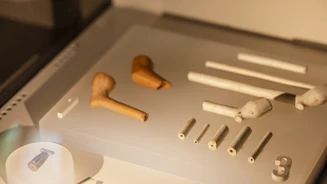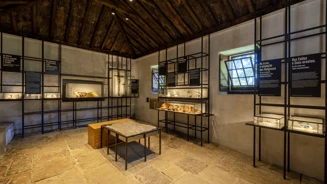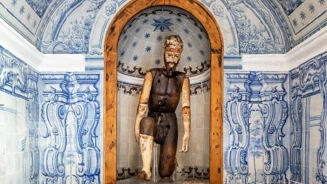Archaeological finds as yet unseen by the public reveal the secret lives of the friars of the Convent of the Capuchos
19 Aug 2024
For the first time, archaeological finds are on display in the new museum centre in the Convent of the Capuchos, housed in the former Granary, which allow us to better understand the lives of the Franciscan friars who lived in this convent house for more than three centuries, including those they would have liked to keep secret. This extensive historical and archaeological research project, carried out since 2011 as part of the monument's overall conservation, restoration and requalification, has brought to light objects that surprised the Parques de Sintra teams, such as pipes and game pieces. These pieces reveal behaviour that transgresses the Order's strict statutes and reflect both the evolution of the Franciscan way of life itself and the paradoxes inherent in the human dimension of the friars.

The duality present in the spaces of the Convent of the Capuchos and in the life of the community that inhabited it is the leitmotif of this museum centre: the spirit and the body; the divine and the human; good and evil; light and shadow; observance and transgression. The exhibition concept is thus based on the contradiction between the austere Statutes of the Province of Arrábida, which governed life in this convent house, and the reality that the objects on display reveal.
Although the Order's statutes clearly state that smoking was forbidden, we now know that some of the friars had kaolin pipes from the 17th century, of Dutch origin. Game pieces, a shaving dish, earthenware crockery and decorated earthenware such as a jug with the inscription ‘Cintra’ and a fragment of a small bowl reading ‘Capuchos’ are other "forbidden" objects that allow us to understand how this community loosened its restrictions over the centuries, a reflection of the human condition. In all, the exhibition comprises around 70 pieces from archaeological research and from the Convent of the Capuchos collection, which has been in reserve since 2000.

Sculpture of "Our Lord of the Steps" returns to the Chapel of the Passion
News at the Convent of the Capuchos doesn't stop there. The carved wooden figure of "Our Lord of the Steps", which has been in reserve since 2006, is back in the Chapel of the Passion following a restoration project which consisted of removing repainting and filling in gaps in the wooden support.
Of unknown authorship, it is an articulated piece representing Jesus Christ on his way to Calvary. The sculpture bears witness to the artistic representations typical of the 18th century, a period deeply marked by religious fervour. With realistic detailing, emotive expressions and a carefully crafted narrative, it evokes the Passion of Christ and aims to provide an immersive spiritual experience. Its return to the Chapel of the Passion allows for a better interpretation of the space.

